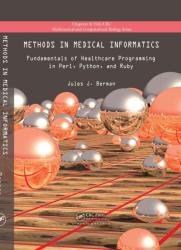Methods in Medical Informatics: Fundamentals of Healthcare Programming in Perl, Python, and Ruby
- Добавил: literator
- Дата: 31-12-2021, 15:58
- Комментариев: 0
 Название: Methods in Medical Informatics: Fundamentals of Healthcare Programming in Perl, Python, and Ruby
Название: Methods in Medical Informatics: Fundamentals of Healthcare Programming in Perl, Python, and RubyАвтор: Jules J. Berman
Издательство: CRC Press
Год: 2014
Страниц: 402
Язык: английский
Формат: pdf (true)
Размер: 10.2 MB
Too often, healthcare workers are led to believe that medical informatics is a complex field that can only be mastered by teams of professional programmers. This is simply not the case. With just a few dozen simple algorithms, easily implemented with open source programming languages, you can fully utilize the medical information contained in clinical and research datasets. The common computational tasks of medical informatics are accessible to anyone willing to learn the basics. Methods in Medical Informatics: Fundamentals of Healthcare Programming in Perl, Python, and Ruby demonstrates that biomedical professionals with fundamental programming knowledge can master any kind of data collection. Providing you with access to data, nomenclatures, and programming scripts and languages that are all free and publicly available, this book:
Describes the structure of data sources used, with instructions for downloading
Includes a clearly written explanation of each algorithm
Offers equivalent scripts in Perl, Python, and Ruby, for each algorithm
Shows how to write short, quickly learned scripts, using a minimal selection of commands
Teaches basic informatics methods for retrieving, organizing, merging, and analyzing data sources
Provides case studies that detail the kinds of questions that biomedical scientists can ask and answer with public data and an open source programming language
Requiring no more than a working knowledge of Perl, Python, or Ruby, Methods in Medical Informatics will have you writing powerful programs in just a few minutes. Within its chapters, you will find descriptions of the basic methods and implementations needed to complete many of the projects you will encounter in your biomedical career.
This book provides step-by-step instructions for applying basic informatics algorithms to medical data sets. It is written for students and professionals in the healthcare field who have some working knowledge of Perl, Python, or Ruby. Most of our future data analysis efforts will build on the computational approaches and programming routines developed in this book.
Perl, Python, and Ruby are free, readily available, open source programming languages that can be used on any operating system including Windows, Linux, and Mac. Most people who work in the biomedical sciences and develop their own programming solutions, perform at least some of their programming with one of these three languages. These languages are popular, in part because they are easy to learn.
Without becoming a full-time programmer, you can write powerful programs, in just a few minutes and a few lines of code, with any of these languages. We will use a minimal selection of commands to write short scripts that can be learned quickly by biomedical students and professionals. This book demonstrates that, with a few programming methods, biomedical professionals can master any kind of data collection. We provide equivalent scripts in Perl, Python, and Ruby, so that anyone with some programming skill will benefit. Each trio of scripts is preceded by a step-by-step explanation of the algorithm, in plain English. You may wish to confine your attention to scripts written in your preferred language.
The book is divided into four parts:
Part I - Fundamental Algorithms and Methods of Medical Informatics (Chapters 1 to 4) provides simple methods for viewing text and image files, and for parsing through large data sets line by line, retrieving, counting, and indexing selected items. The primary purpose of these chapters is to introduce the basic computational subroutines that are used in more complex scripts later in the book. The secondary purpose of these chapters is to demonstrate that Perl, Python, and Ruby are quite similar to one another, and provide equivalent functionality.
Part II - Medical Data Resources (Chapters 5 to 13) demonstrates uses of some freely available biomedical data sets.
Part III - Primary Tasks of Medical Informatics (Chapters 14 to 18) covers some of the computational methods of biomedical informatics, including autocoding, data scrubbing, and data deidentification.
Part IV - Medical Discovery (Chapters 19 through 27) provides examples of the kinds of questions that biomedical scientists can ask and answer with public data and open source programming languages.
Скачать Methods in Medical Informatics: Fundamentals of Healthcare Programming in Perl, Python, and Ruby
Внимание
Уважаемый посетитель, Вы зашли на сайт как незарегистрированный пользователь.
Мы рекомендуем Вам зарегистрироваться либо войти на сайт под своим именем.
Уважаемый посетитель, Вы зашли на сайт как незарегистрированный пользователь.
Мы рекомендуем Вам зарегистрироваться либо войти на сайт под своим именем.
Информация
Посетители, находящиеся в группе Гости, не могут оставлять комментарии к данной публикации.
Посетители, находящиеся в группе Гости, не могут оставлять комментарии к данной публикации.
